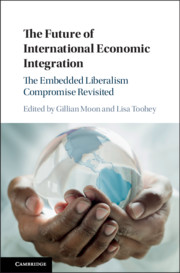Book contents
- The Future of International Economic Integration
- The Future of International Economic Integration
- Copyright page
- Contents
- Contributors
- Foreword
- Preface
- Acronyms
- Part I The Concept of the Embedded Liberalism Compromise
- Part II The Dynamic of the Embedded Liberalism Compromise
- Part III Engineering the Embedded Liberalism Compromise: Addressing the Future in Times of Turmoil
- 10 Embedded Liberalism As a Framework for Description, Critique and Advocacy
- 11 Embedded Liberalism and Global Business
- 12 The Embedded Liberalism Compromise and Cultural Policy Measures
- 13 The WTO’s Purpose, Regulatory Autonomy and the Future of the Embedded Liberalism Compromise
- Index
13 - The WTO’s Purpose, Regulatory Autonomy and the Future of the Embedded Liberalism Compromise
from Part III - Engineering the Embedded Liberalism Compromise: Addressing the Future in Times of Turmoil
Published online by Cambridge University Press: 21 September 2018
- The Future of International Economic Integration
- The Future of International Economic Integration
- Copyright page
- Contents
- Contributors
- Foreword
- Preface
- Acronyms
- Part I The Concept of the Embedded Liberalism Compromise
- Part II The Dynamic of the Embedded Liberalism Compromise
- Part III Engineering the Embedded Liberalism Compromise: Addressing the Future in Times of Turmoil
- 10 Embedded Liberalism As a Framework for Description, Critique and Advocacy
- 11 Embedded Liberalism and Global Business
- 12 The Embedded Liberalism Compromise and Cultural Policy Measures
- 13 The WTO’s Purpose, Regulatory Autonomy and the Future of the Embedded Liberalism Compromise
- Index
Summary
- Type
- Chapter
- Information
- The Future of International Economic IntegrationThe Embedded Liberalism Compromise Revisited, pp. 222 - 242Publisher: Cambridge University PressPrint publication year: 2018



